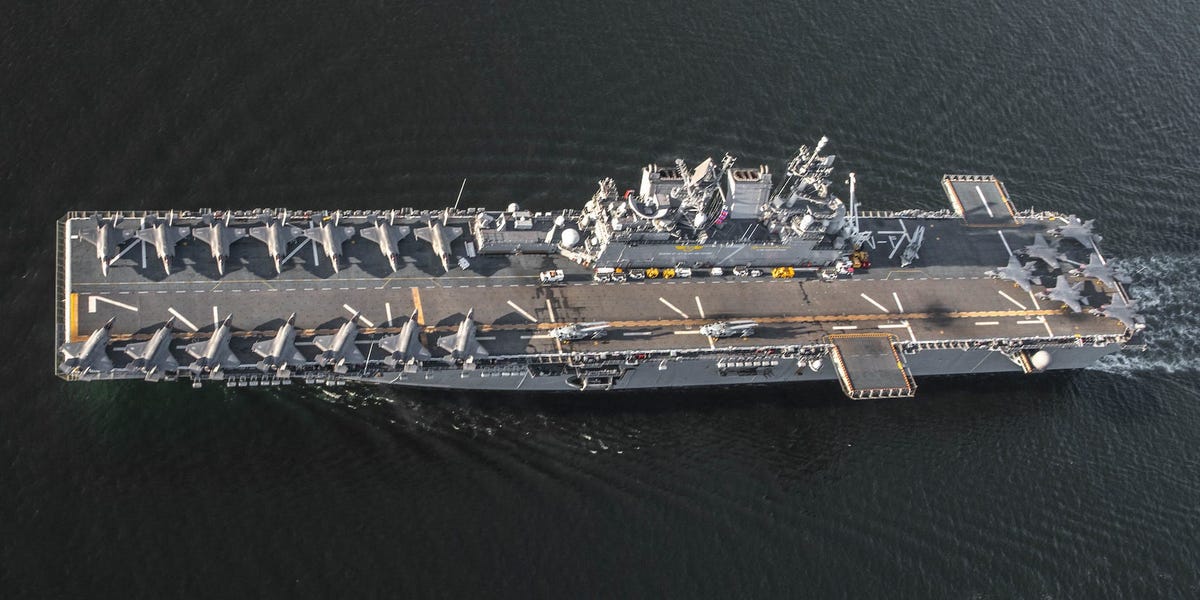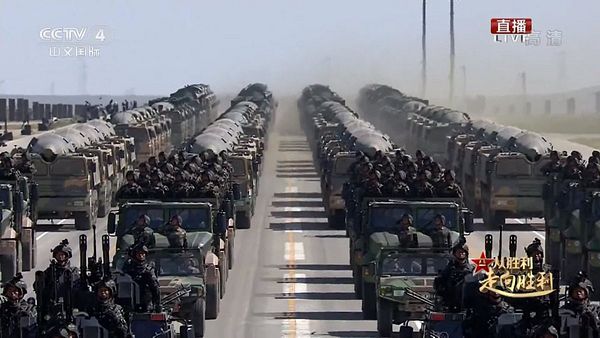F-22Raptor
ELITE MEMBER

- Joined
- Jun 19, 2014
- Messages
- 16,980
- Reaction score
- 3
- Country
- Location
At an event hosted by the US Naval Institute and the Center for Strategic and International Studies in October, Vice Adm. Karl Thomas, commanding officer of the US Navy's 7th Fleet, talked about one of the ways the Navy is working to expand its firepower in the region.
Over the summer, the Navy and the Marine Corps continued experimenting with the "Lighting Carrier" concept, which envisions US Navy amphibious assault ships stocked with US Marine Corps F-35B fighter jets to project power as part of a more distributed force.
USS Tripoli, an amphibious assault ship designed to carry Marines, helicopters, and vertical-takeoff aircraft, spent several months this year sailing with more than dozen F-35Bs, operating like a light aircraft carrier than a standard amphibious ship.
A light aircraft carrier embarks with fewer jets than a fleet aircraft carrier — as many as 20, compared to more than 50 on a fleet carrier — but it costs much less and is more versatile.
Because of that, Tripoli's commanding officer refers to the configuration as an "assault carrier" rather than "lighting carrier," according to Thomas, whose command is responsible for US Navy operations in the western Pacific.
"One day you can have F-35Bs on the flight deck. The next day you can have MV-22s and you can be putting Marines at the shore, and so it just is a very versatile instrument," Thomas said of the lightning carrier.
The Navy is still experimenting with how to integrate the lighting carrier with "a full-size carrier" and its carrier strike group, which is composed of a carrier, escort ships for defense and resupply, and at least one submarine. Thomas said the Navy had two of its nuclear-powered carriers operating with Tripoli during the Valiant Shield exercise in June.
Interestingly, Thomas also said that an amphibious assault ship, designated an LHA, in the lighting-carrier configuration is much more capable than the two aircraft carriers that China has in service.
"I will note that LHA with 14 F-35Bs is much more capable than either of the PRC's current carriers, both from a sortie-creation perspective as well as just a sheer capability," Thomas said.
The F-35B Lighting II is the short-takeoff and vertical-landing variant of the F-35 Joint Strike Fighter, a fifth-generation fighter with advanced capabilities. In addition to being a STOVL jet, the F-35B's array of sensors allow it to act as a battlefield hub, relaying information to friendly forces across a wide area.
"There is no comparison between a J-15 and an F-35B," Thomas said, referring to China's main carrier aircraft.
A lightning carrier also allows allies and partners "to see the capability you can bring with the F-35Bs on the flattop," Thomas said, pointing to the UK, which sent a carrier embarked with F-35Bs to the Pacific last year, and to Japan, which is converting two helicopter carriers to operate F-35Bs.

Over the summer, the Navy and the Marine Corps continued experimenting with the "Lighting Carrier" concept, which envisions US Navy amphibious assault ships stocked with US Marine Corps F-35B fighter jets to project power as part of a more distributed force.
USS Tripoli, an amphibious assault ship designed to carry Marines, helicopters, and vertical-takeoff aircraft, spent several months this year sailing with more than dozen F-35Bs, operating like a light aircraft carrier than a standard amphibious ship.
A light aircraft carrier embarks with fewer jets than a fleet aircraft carrier — as many as 20, compared to more than 50 on a fleet carrier — but it costs much less and is more versatile.
Because of that, Tripoli's commanding officer refers to the configuration as an "assault carrier" rather than "lighting carrier," according to Thomas, whose command is responsible for US Navy operations in the western Pacific.
"One day you can have F-35Bs on the flight deck. The next day you can have MV-22s and you can be putting Marines at the shore, and so it just is a very versatile instrument," Thomas said of the lightning carrier.
The Navy is still experimenting with how to integrate the lighting carrier with "a full-size carrier" and its carrier strike group, which is composed of a carrier, escort ships for defense and resupply, and at least one submarine. Thomas said the Navy had two of its nuclear-powered carriers operating with Tripoli during the Valiant Shield exercise in June.
Interestingly, Thomas also said that an amphibious assault ship, designated an LHA, in the lighting-carrier configuration is much more capable than the two aircraft carriers that China has in service.
"I will note that LHA with 14 F-35Bs is much more capable than either of the PRC's current carriers, both from a sortie-creation perspective as well as just a sheer capability," Thomas said.
The F-35B Lighting II is the short-takeoff and vertical-landing variant of the F-35 Joint Strike Fighter, a fifth-generation fighter with advanced capabilities. In addition to being a STOVL jet, the F-35B's array of sensors allow it to act as a battlefield hub, relaying information to friendly forces across a wide area.
"There is no comparison between a J-15 and an F-35B," Thomas said, referring to China's main carrier aircraft.
A lightning carrier also allows allies and partners "to see the capability you can bring with the F-35Bs on the flattop," Thomas said, pointing to the UK, which sent a carrier embarked with F-35Bs to the Pacific last year, and to Japan, which is converting two helicopter carriers to operate F-35Bs.
Lightning carriers more capable than China's carriers, US admiral says
An amphibious assault ship loaded with more than a dozen F-35Bs "just is a very versatile instrument," the head of the US Navy's 7th Fleet said.
www.businessinsider.com






